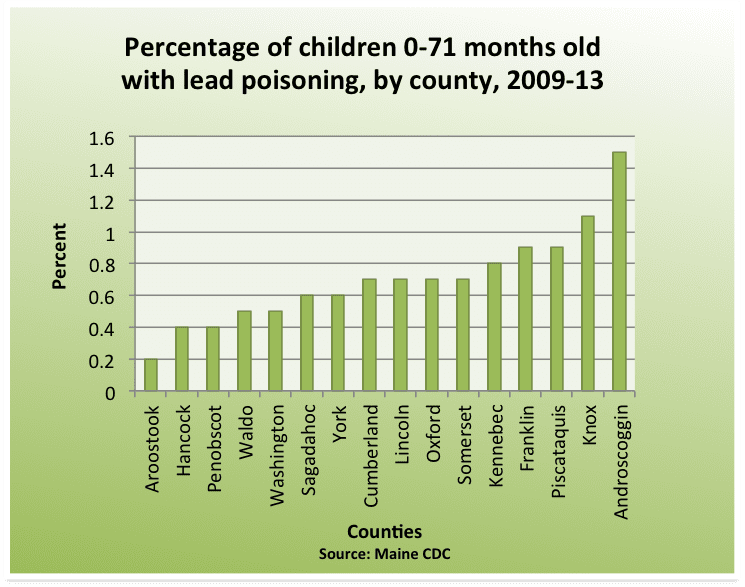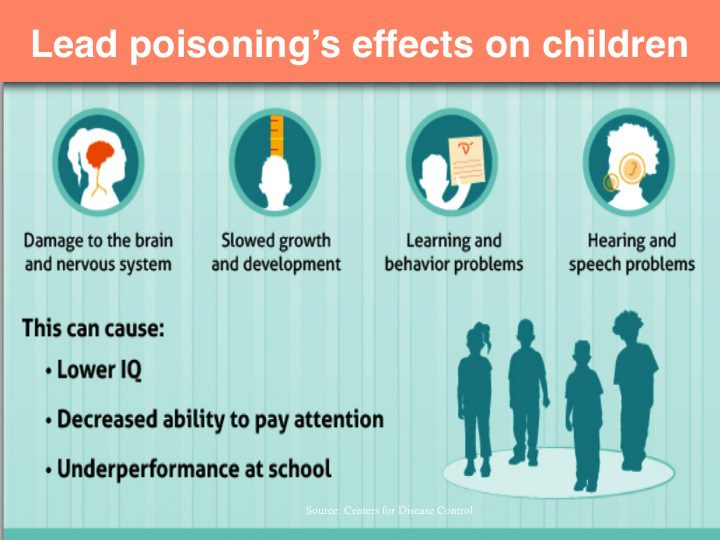Childhood lead poisoning: It’s the problem that everyone thinks has gone away.
But everyone is wrong.
Lead poisoning was the headline-grabbing public health controversy of the 1970s and 80s, but later got pushed to the back pages by fresher issues, like the industrial chemical called BPA used in toys or the flame retardants in children’s clothing.
But, while politicians and the media took up trendier topics about toxic health hazards, lead was still poisoning tens of thousands of children from the paint in older homes, especially in states like Maine, which has the sixth oldest housing stock in the country.
The problem was so serious that in 1991 the Maine legislature passed a law promising to eradicate childhood lead poisoning by 2010.

While some progress was made following passage of that law, five years after that deadline thousands of Maine children are still being poisoned by licking surfaces covered with lead paint dust, licking their hands and fingers after touching lead dust or breathing in the lead dust floating in the air around their homes.
The Maine Center for Public Interest Reporting spent six months investigating the problem by examining state and national data, and interviewing the top experts in the field, public health officials, landlords and tenants.
The findings include:
• Lead is still “the number one health hazard for children,” stated Dr. David Bellinger, a Harvard environmental epidemiologist and pediatric neuropsychologist who is one of the nation’s leading experts on childhood lead poisoning.
• Experts know how to solve the problem — by removing lead paint from homes or maintaining it so that it does not chip, peel or break down — but public officials have instead chosen a cheaper, stopgap approach that means lead poisoning will be around indefinitely.
• The primary way officials discover unsafe levels of lead in a home is to use children as “canaries in the mine,” as one official said. Doctors or health officials report a poisoned child and then property owners have to clean up the source of the poisoning. “It’s a sick part of the system we have, waiting for children to be poisoned, then identifying the homes,” said Dr. Dora Mills, who was Maine’s director of public health from 1996 to 2011.
• The most likely victim of lead poisoning in Maine is a poor child because the poor live in older, cheaper rental housing for which there is no financial incentive for landlords to remove the layers of lead paint. Lewiston and Auburn have three times the rate of childhood lead poisoning — often among Somali immigrants — than the rest of the state.
‘A huge problem’
How many Maine children have been poisoned by lead? No one knows for sure, because only about 50 percent of one- to two-year-olds statewide were systematically tested during 2009-2013, the most recent years for which data are available, and only 27 percent of two to three year olds were tested. Those age groups are considered to be the most vulnerable because of frequent “hand-to-mouth activity and a higher absorption of any lead that they take into their bodies,” Mills told a legislative committee in 2005.

Available data show that in 1997, for example, there were 400 children under six newly identified as suffering from lead poisoning. From 2003-2013, the average number of children newly identified each year with lead poisoning was 137, with 79 children in 2013, the most recent year for which data is available.
But two factors suggest the number could be larger.

One factor is that the level of lead in the blood considered high enough by the state to be classified as poisonous has changed, following standards adopted by the national Centers for Disease Control.
Until this year, the level at which a Maine child was considered lead-poisoned was 10 or more micrograms per deciliter of lead in blood. In June, the legislature changed the danger level to five micrograms.
With that lower threshold, hundreds more children per year in Maine will be diagnosed with lead poisoning. And even that number may fail to capture cases of genuine lead poisoning, because medical experts say any level is dangerous.
The second factor that suggests a larger problem, is the number of children living in housing units the state says pose a lead paint hazard: nearly 30,000 kids under six live in housing built before 1950, which has the highest probability of being lead-contaminated. Even if just one percent have lead poisoning, that’s 300 kids; three percent is 900 children.
Dr. Mills, the former state public health director, a pediatrician and the current vice president for clinical affairs at the University of New England in Biddeford, put it bluntly: There is “a huge lead problem in the state.”
Your brain on lead
One fact about lead poisoning that is well-established is what it does to the human brain after it gets into the bloodstream: “It will scramble up the way the brain works.”
Those are the words of Dr. Bellinger.
The lead, he explains, interferes with the neurotransmitters, the chemicals that pass information between brain cells.
Lead “introduces noise” to that system, “makes cells fire when they shouldn’t and inhibits cells when they should be firing,” Dr. Bellinger said.
All that means a child with lead poisoning could have impulse control problems, inability to delay gratification, an increased chance of failing in school and of getting arrested, he said.

While these types of problems from lead poisoning have been under the radar in recent years, the Baltimore riots in April put the topic back on the front page for a moment. Freddie Gray, the young black man killed in police custody, was poisoned by lead in the house he grew up in, according to a suit that was settled out of court.
On April 29, the Washington Post reported: “Even at such a young age, his (Gray’s) blood contained more than 10 micrograms of lead per deciliter of blood — double the level at which the Center for Disease Control urges additional testing. Three months later, his blood had nearly 30 micrograms. In June 1991, when Gray was 22 months old, his blood carried 37 micrograms.
“’Jesus,’ Dan Levy, an assistant professor of pediatrics at Johns Hopkins University who has studied the effects of lead poisoning on youths, gasped when told of Gray’s levels. ‘The fact that Mr. Gray had these high levels of lead in all likelihood affected his ability to think and to self-regulate and profoundly affected his cognitive ability to process information.’”
Lead banned, but still here
In the 1970s, the federal government banned lead from gasoline and residential paint. In 1995, the use of lead solder in food cans was also banned.
The resulting decline in Americans’ exposure to lead has been hailed as one of the great public health victories of the 20th Century.
“Over the past three decades, blood lead levels of children and adults have plummeted as a result of bans on lead in gasoline, paint, and solder used in canned foods,” wrote physician and lead researcher Dr. Bruce Lanphear in 2007.
But as Lanphear notes in his essay, “The Conquest of Lead Poisoning: A Pyrrhic Victory,” the lead didn’t go away, and the victory was only partial. While the federal government had moved to protect children from a destructive toxin, those actions only took care of new sources of exposure to the toxic metal.
Banning lead from paint, food cans and gas did nothing to get rid of the leaded paint that remained on the walls of buildings built before 1978. It did nothing to get rid of the lead-laden soil next to heavily trafficked roads. And it did nothing to get rid of the lead-saturated soil next to old buildings whose paint had chipped off and fallen onto the ground.
It did create a sense of false safety about lead.
In part, lead’s enduring threat reflects that scientists now understand that it can disrupt brain functioning at much lower levels than was thought in the 1970s. So the acutely toxic cases of lead poisoning that lead to death are rarely, if ever, seen anymore.

And because the heyday of anti-lead poisoning advocacy occurred in the 1970s, “it’s a sort of quiet childhood threat that nobody really thinks about any more,” said former Maine legislator and public health foundation executive Lisa Miller. Miller did lead testing on children in Portland in the 1980s.
Yet the lead that remains in and around homes is quietly poisoning children at much lower levels than previously understood.
For example: With a blood level of just 5 micrograms per deciliter, a lead-poisoned child is 30 percent more likely to fail third grade reading and math tests and more likely to be non-proficient in math, science, and reading, according to studies of tens of thousands of children in Chicago and Detroit.
“Other things get a lot more attention these days — bisphenol and brominated flame retardants — but there’s no question that lead is worse than we thought back in the ‘70s,” said Harvard’s Dr. Bellinger.
But childhood lead poisoning is a preventable problem. If all the deteriorating lead paint that poisons children were cleaned up, children wouldn’t get poisoned.
“We know how to prevent lead poisoning; we just haven’t done it,” said Bellinger. “It’s fairly simple — this is not a complex technical problem. Just get rid of all the lead paint in the country.”
John Christie contributed to this story. The research and writing of this story was supported by a grant from the Emanuel and Pauline A. Lerner Foundation. This is part one of a four-part series.







